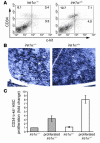The unfolded protein response sensor IRE1alpha is required at 2 distinct steps in B cell lymphopoiesis
- PMID: 15690081
- PMCID: PMC546421
- DOI: 10.1172/JCI21848
The unfolded protein response sensor IRE1alpha is required at 2 distinct steps in B cell lymphopoiesis
Abstract
B lymphocyte differentiation is coordinated with the induction of high-level Ig secretion and expansion of the secretory pathway. Upon accumulation of unfolded proteins in the lumen of the ER, cells activate an intracellular signaling pathway termed the unfolded protein response (UPR). Two major proximal sensors of the UPR are inositol-requiring enzyme 1alpha (IRE1alpha), an ER transmembrane protein kinase/endoribonuclease, and ER-resident eukaryotic translation initiation factor 2alpha (eIF2alpha) kinase (PERK). To elucidate whether the UPR plays an important role in lymphopoiesis, we carried out reconstitution of recombinase-activating gene 2-deficient (rag2-/-) mice with hematopoietic cells defective in either IRE1alpha- or PERK-mediated signaling. IRE1alpha-deficient (ire1alpha-/-) HSCs can proliferate and give rise to pro-B cells that home to bone marrow. However, IRE1alpha, but not its catalytic activities, is required for Ig gene rearrangement and production of B cell receptors (BCRs). Analysis of rag2-/- mice transplanted with IRE1alpha trans-dominant-negative bone marrow cells demonstrated an additional requirement for IRE1alpha in B lymphopoiesis: both the IRE1alpha kinase and RNase catalytic activities are required to splice the mRNA encoding X-box-binding protein 1 (XBP1) for terminal differentiation of mature B cells into antibody-secreting plasma cells. Furthermore, UPR-mediated translational control through eIF2alpha phosphorylation is not required for B lymphocyte maturation and/or plasma cell differentiation. These results suggest specific requirements of the IRE1alpha-mediated UPR subpathway in the early and late stages of B lymphopoiesis.
Figures







Comment in
-
Birth pangs: the stressful origins of lymphocytes.J Clin Invest. 2005 Feb;115(2):224-7. doi: 10.1172/JCI24238. J Clin Invest. 2005. PMID: 15690077 Free PMC article. Review.
References
-
- Hardy RR, Hayakawa K. B cell development pathways. Annu. Rev. Immunol. 2001;19:595–621. - PubMed
-
- Calame KL. Plasma cells: finding new light at the end of B cell development. Nat. Immunol. 2001;2:1103–1108. - PubMed
-
- Meffre E, Casellas R, Nussenzweig MC. Antibody regulation of B cell development. Nat. Immunol. 2000;1:379–385. - PubMed
-
- Cox JS, Walter P. A novel mechanism for regulating activity of a transcription factor that controls the unfolded protein response. Cell. 1996;87:391–404. - PubMed
-
- Harding HP, Calfon M, Urano F, Novoa I, Ron D. Transcriptional and translational control in the Mammalian unfolded protein response. Annu. Rev. Cell Dev. Biol. 2002;18:575–599. - PubMed
Publication types
MeSH terms
Substances
Grants and funding
LinkOut - more resources
Full Text Sources
Other Literature Sources
Molecular Biology Databases
Research Materials

